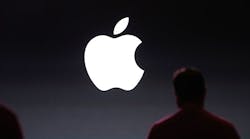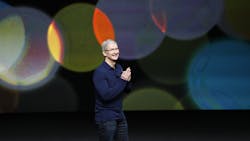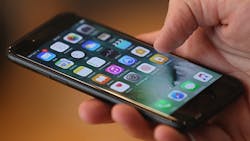Apple Inc. (IW 500/2) has big plans to outfit its next iPhone with vibrant, energy-sipping organic LED displays, seeking to entice consumers with new technology that’s already been embraced by other high-end smartphone makers.
The trouble is that the four main suppliers for such components won’t have enough production capacity to make screens for all new iPhones next year, with constraints continuing into 2018, people familiar with the matter said, presenting a potential challenge for the Cupertino, Calif.-based company.
OLED screens are more difficult to produce, putting Apple at the mercy of suppliers that are still working to manufacture the displays in mass quantities, the people said. The four largest producers are Samsung Display Co., LG Display Co., Sharp Corp., and Japan Display Inc. While Samsung is on track to be the sole supplier for the new displays next year, the South Korean company may not be able to make enough due to low yield rates combined with increasing iPhone demand.
The supply constraints may force Apple to use OLED in just one version of the next-generation iPhone, push back adoption of the technology or cause other snags.
"Apple has already figured in there will be high demand for the OLED model and they’ve also figured out there will be constraints to these panels," said Dan Panzica, a supply chain analyst at IHS Markit. The combination of Apple’s stringent quality requirements and the difficulty of producing OLED panels will likely lead to supply constraints, he said.
Apple plans to ship at least one new iPhone with an OLED screen next year, the 10th anniversary of the smartphone’s debut, people with knowledge of the matter said. A pair of other new iPhone models will likely feature screens that use older LCD technology, partly because there won’t be enough OLED displays to satisfy anticipated demand, according to KGI Securities analyst Ming-Chi Kuo.
"Display technology is still a pretty key driver of the purchasing experience," said Ben Bajarin, an analyst at Creative Strategies. Apple has previously used new display features as iPhone selling points. For example, the iPhone 4 in 2010 added Apple’s first Retina Display, the iPhone 5 in 2012 introduced the iPhone’s first display size increase, and the iPhone 6 in 2014 brought new 4.7-inch and 5.5-inch screen options.
The OLED iPhone, at least, will have a new look that extends glass from the display to the device’s back and edges, according to a person familiar with Apple’s plans. This all-glass design will have a virtual Home button embedded in an edge-to-edge screen, rather than a physical button that can be pressed, the person added.
An Apple spokeswoman declined to comment.
Apple typically introduces new technologies for its iPhones across all models when they’re unveiled every September, as it did for 3D Touch and Apple Pay. Using different core, user-facing technology in the same iPhone generation would be an unusual step. All current iPhone 7 models have LCD screens. Still, Apple may have no choice.
Sharp and Japan Display are still working on test procedures for OLED screens and have said that they are on track for production in 2018, while seeking to manage expectations.
“There is all this talk about OLEDs, but I’m not at all sure about their future,” Sharp President Tai Jeng Wu told reporters recently. “We need to work on developing the technology, but whether we can succeed remains to be seen.”
Shuji Aruga, president of Japan Display, said earlier this month that he sees a 50-50 split between OLEDs and LCDs that will be used in high-end phone screens. “We are not yet at a stage where we can decisively choose between OLED and LCD,” he said. “We need to develop OLED capacity so that we are not caught empty-handed if the technology does end up capturing a majority.”
LG Display Late to Invest
LG Display is the laggard. “It’s true that we were late in OLED investment for smaller electronics devices compared to that of televisions,” LG Display Chief Executive Officer Han Sang-beom said earlier this year, adding that the company now understands OLED’s importance for smartphones.
Apple and Samsung have an exclusive OLED supply deal for 2017, people with knowledge of the agreement said. Still, that doesn’t guarantee the South Korean technology giant will have enough output to meet demand for the revamped iPhone. For example, Samsung’s OLED supplies have even been constrained for its own mobile division’s smartphones. A representative for Samsung Display declined to comment.
Apple’s initial OLED order from Samsung is for 100 million units over one year, according to people familiar with the agreement. Even so, Samsung will probably only be able to deliver a portion of that for the 2017 holiday period. Apple shipped about 75 million iPhones in the 2015 holiday quarter, and some analysts estimate that as many as 90 million could be sold in the last three months of 2017.
The OLED screens ordered by Apple in the Samsung deal are for displays larger than 5 inches, a person familiar with the matter said. If Samsung sees supply constraints in its ramp up of OLED panels for the fall 2017 iPhone launch, Apple may not have another major provider to fall back on. That’s why Apple usually has multiple suppliers for key components. For example, it has sourced LCD panels from all of the major Asia-based display makers. For next year, at least, it appears that OLED supply chain may be a single-company affair.
Apple has run into supply problems before, for example when it sought to adopt tough sapphire screens for the iPhone 6 in 2014. Even though it financed a sole supplier, GT Advanced Technologies Inc., to ramp up production and deliver the material, the manufacturer wasn’t able to deliver enough sapphire glass of acceptable quality. As a result, Apple abandoned plans to use stronger screens, and GT Advanced ended up seeking bankruptcy protection.
By Mark Gurman and Jungah Lee






